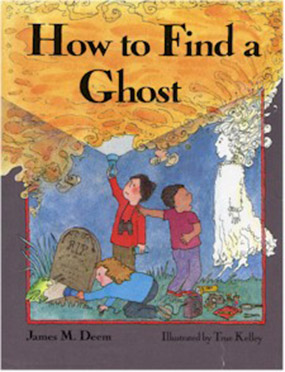Hardcover edition, 1988.Paperback edition, 1990. |
Selected Stories from this Book ~~ Related Books by James M Deem: How to Hunt for Buried Treasure How to Read Your Mother's Mind ~~ |
Have you ever wondered what it would be like to see a ghost?
Well, I did. I was obsessed with ghosts from the time that I was four years old. I was afraid that my house was haunted. At night, I sometimes heard creaking noises moving across the floor in the attic above me. And there was a strange half-size door on the back wall of my bedroom closet which was the perfect height for a small ghost to squeeze through.
Despite my fascination with ghosts, I never managed to see one until I was over 30 years old. Here's what happened:
I saw a ghost once (I think, unless I was mistaken); it wasn't scary at all. I didn't even know I had seen a ghost until it was gone. My wife and I were visiting Richmond Castle in England when we were walking up an old stone staircase to the second floor of the keep.
At the top of the stairs I saw a woman in a blue dress walk by. When we got to the second floor, the woman was gone--and there was no other way down from the floor. I decided that she must have been a ghost (otherwise, how could she disappear?), though I can't prove it. Of course, she also could have been a figment of my imagination (a blur as I turned my head). Whatever I saw (or didn't see), it wasn't a terrifying experience; it simply happened.
Given my interest in ghosts, I suppose it was no wonder that I used it as the basis for my first nonfiction book, How to Find a Ghost.
To research the book, I read as many real ghost stories as I could. These stories were found in the archives of paranormal investigation societies in New York and London. Based on these stories, I reached some conclusion about where ghosts come from and what they really look like. The book:
-
describes six different types of ghosts, from the one that dwells in a haunted house to the mischievous poltergeist, and suggests how you can begin your own ghost hunt (hint: start in your local library, not the the local cemetery).
-
lists "Ten Ways to Find a Ghost"--did you know that your chances are better if you stay indoors and read a book?--and gives scientific advice on how to prove your ghost really exists and how to write up a convincing Ghost Report.
By the time you're done, you'll be a tried and true Ghost Detective.
The book was well-received. I still receive emails from many adults who read the book as children and fondly remember it.
Reviews
School Library Journal (November 1988): "This is a how-to-be haunted manual for aspiring junior ghostbusters. Written with a mixture of seriousness and chuckles reminiscent of campfire ghost story sessions, the book describes several different kinds of ghosts that a ghost hunter might encounter, and suggests places where the ghosts might be found. Deem also provides tips on how to conduct a ghost investigation. He includes a sample form for recording other worldly experiences, and even an address to send in ghost hunting experiences. The book is filled with 'true ghost accounts' told with the same blend of smiles and shivers...this will be welcomed by middle-grade ghost fanciers."
Booklist (November 1, 1988): "An unusual and entertaining title that will undoubtedly prove fascinating and popular with upper-grade students."
Bulletin for the Center of Children's Books (November 1988): "...young readers may want to grab a flashlight and head for the nearest likely haunt...."
Kirkus Reviews (August 1, 1988): "A handbook for novice ghost-hunters, pleasantly free of both stubborn skepticism and mystical mumbo-jumbo. 'To find a ghost you must be brave, determined and, most of all, patient,' the author warns, but meanwhile he offers plenty of encouragement--as well as a sense that ghosts aren't all that hard to find once you now how and where to look.... Must reading for armchair investigators, as well as for more active detectives."
